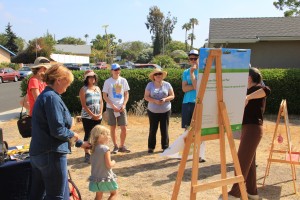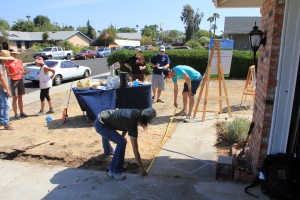
Turning away from the tradition of a lawn with sprinklers may seem extreme to some.
But the truth about turf is that it’s too thirsty for Southern California’s arid climate, especially during a drought.
Why does this matter to Surfrider, a grassroots conservation group dedicated to cleaner coastal water?
Over-watering of landscaping is a leading source of runoff. This wasted water transports oil, bacteria and other contaminants –a flow nicknamed “urban drool” -- into waterways that flow downstream to the ocean.
These ideas were swirling in the minds of about 15 folks who turned out for Surfrider’s Ocean Friendly Gardens’ hands-on workshop in June.
The workshop was held at the Carlsbad home of Hallie Thompson and husband Mathieu De Champ Savin. The couple had turned off their sprinklers over the winter, and on the day of the workshop it was as brown and dry as unbuttered toast.
Each demonstration home chosen for a makeover by Ocean Friendly Gardens is visited twice by volunteers: once for a "Hands on Workshop" or "HOW" to take measurements and plan the new landscaping scheme, and another for a "Garden Assistance Party" or "GAP" to physically install it.
“This is a fabulous program. We’re excited.” Thompson said. The Ocean Friendly Garden program teaches folks how to replace lawns with drought-tolerant landscaping that actually holds and filters pollutants.
Thompson, who works for City of Carlsbad’s stormwater department, said her love of surfing and the ocean motivated her to take the leap of living without a lawn. She is one of the first on her block in suburbia to make such a decision. Neighbors surrounding her all had front yards as green as a golf course.
In Thompson’s case, a friend who is a landscape designer created a plan that calls for converting the dead lawn into a landscape that will imitate a dry riverbed with stones and native plants. The design follows Surfrider's established criteria for a certified "Ocean Friendly Garden".
Creating a non-polluting, water efficient landscape is not without costs, but there are local programs that can help. The San Diego County Water Authority offers a rebate program that pays homeowners $2.50 per square foot of lawn that is removed and reconfigured into a water-wise landscape. Various cities throughout the County also offer their own rebates that can be combined with water agency rebates.
Ocean Friendly Garden co-chair and horticulturist Susan Krzywicki began the workshop with a brief lecture on the key concepts behind the program.
“We’re using our drinking water on our lawn,” she said. “And an average of 25 percent of the water used for irrigation is running off the streets and into the storm drains.”
When you set out to create an ocean-friendly landscape, she said, your efforts should focus on three objectives in regards to the use of water: conservation, permeability and retention.
The first step in the process is to develop a site map to understand how water interacts with the property.
After the participants measured the dimensions of the front and back yards, she calculated that a new waterwise landscape could reduce Thompson’s irrigation needs from 120,000 gallons per year to about 24,000 gallons annually...
 Volunteers take measurements of the lawn and impervious surfaces, which include the roof, driveways, and sidewalks.
Volunteers take measurements of the lawn and impervious surfaces, which include the roof, driveways, and sidewalks.
“Water conservation is not our main goal –downstream water quality is,” said Shauna McKellar, who co-chairs the program for San Diego Surfrider. “But there are a lot of indirect benefits of water conservation that help water quality, such as energy savings and reduced overspray from sprinklers which cause dry weather urban runoff. Also, by planting native plants in lieu of grass, you are providing habitat for native wildlife which helps support the ecosystem as a whole.”
The volunteers also measured the roof to estimate its potential to funnel stormwater into rain barrels. Every 500 square feet of roof can fill a 50-gallon rain barrel with only a meager .16 inches of rain. Overflow from the rain barrels can be directed into a dry stream or other vegetated area where it can be stored in the soil.
"Nature is giving us free water. It seems silly to just send it unused into the gutter," said Krzywicki.
One workshop participant, Kathy Schulte, said she previously had been skeptical about installing rain barrels at her home because of San Diego's arid climate (San Diego receives on average 10 inches of rain annually).
“I’m going home to tell my husband he was right about the rain barrel,” she said. “We will definitely be getting one.”
To demonstrate the deficiencies of typical lawn sprinklers, participants placed cups throughout the yard and then turned the water on for five minutes.
“I was amazed just how inefficient the sprinklers were at delivering water,” said workshop participant Lei Huey Jeanes. “It was also interesting to see how uneven the coverage was when we compared the amount of water in each of the cups.”
According to Ocean Friendly Gardens committee member Diane Downey, some traditional sprinklers spray as much water as a shower head.
“It’s also unfortunate that a lot of that water runs right off the property into the storm drain, picking up pollutants along the way,” she said. “And in the case of this home, it goes straight into Agua Hedionda Lagoon were people swim.”
Surfrider's Ocean Friendly Gardens program will be back at Hallie and Mathieu's home for a Garden Assistance Party (GAP) on Saturday, July 12th from 9am-3pm to actually install their new low-water use garden. Volunteers will get their hands dirty and will be planting native and other low-water use plants, as well as helping with a dry stream, spreading mulch, and learning about efficient irrigation options. Members of the community are welcome to attend by RSVPing through Surfrider's volunteer page .


